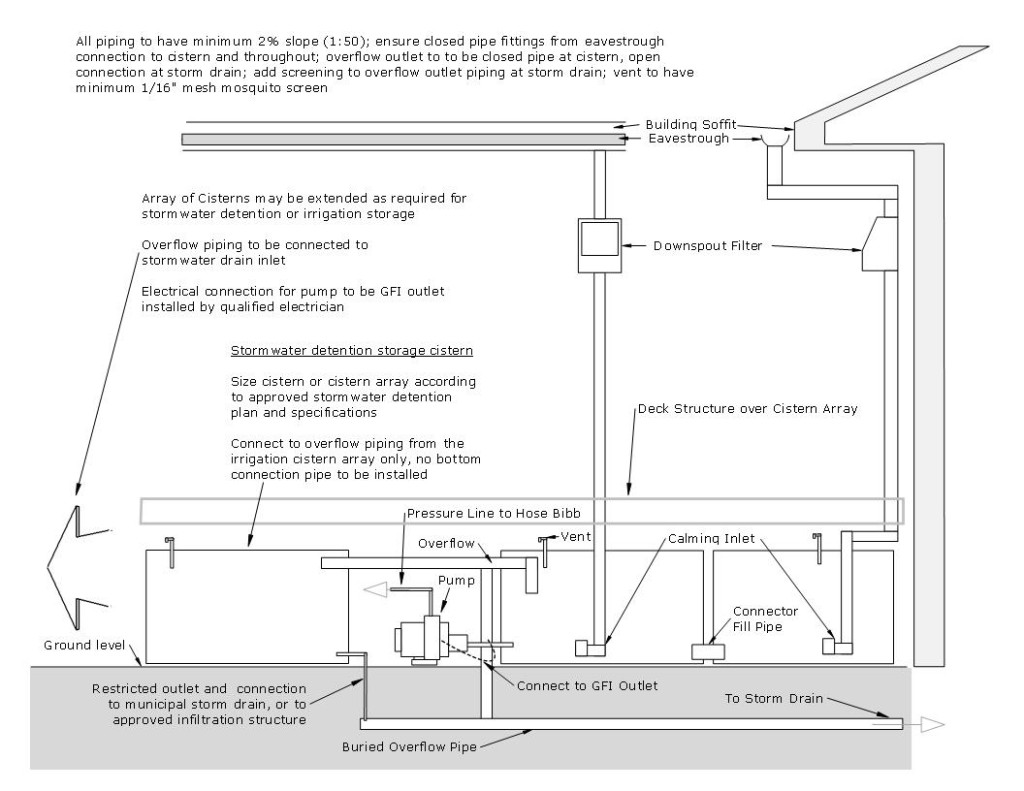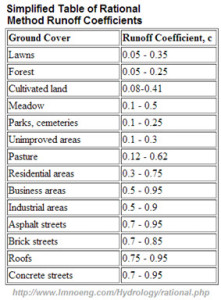Stormwater Detention
The recommendation based on the post-development increased volume of runoff as compared to an estimated pre-development scenario, is to detain approximately 2 cu m of harvested rainwater for slow release into the storm drain. Using a fairly standard 24 hour draw-down period, the release rate would be approximately 1.4 litres / minute (2000/24/60).
The stormwater detention storage is to be added to the under-deck landscape irrigation array of low-profile cistern tanks, and connected with the others in the same manner as previously shown. To meet the 24 hour detention draw-down, a slow-release outlet shall be installed as an open connection to the cistern overflow, which is connected to the municipal storm drain. An alternative method, to retain the stormwater requirements onsite, has not been detailed, pending discussion with the City of Victoria and a soil analysis report.
The above information is preliminary, and is intended to give direction in further discussions with the City of Victoria regarding stormwater retention and detention. Detaining runoff from roofs and hard surfaces from entering the stormwater drainage system directly, helps to mitigate potential flooding, and reduces infrastructure upgrade requirements. Retaining runoff that normally enters the stormwater drainage system helps replenish aquifers and ground water supplies, which feed streams and creeks in local watersheds.
This information may need to be modified to meet new requirements of the Stormwater Utility Billing system being implemented by the City of Victoria, and is not intended for construction purposes at this time.
For the purposes of this evaluation, calculations for the sizing of stormwater detention volumes are based on the Rational Equation Method (as per LMNO Engineering), and compared to the rainwater harvesting calculations shown in CMHC publication 67608, Residential Rainwater Harvesting Guidelines Handbook (CMHC).
Runoff factors of 1.0 for impervious areas and 0.35 for landscaped areas have been used. In the LMNO method, using the standard Rational Equation Method formula, an estimated pre-development peak discharge value was subtracted from the sum of landscaped and developed peak discharge (see chart below). Runoff coefficients are shown in the list to the right. A similar calculation using the CMHC method shows the results in volume of water.
The Rational Equation Formula (LMNO): Q = CiA
Where Q = peak discharge (cu m / sec)
C = runoff co-efficient (0.35 or 35%, and 1.0 or 100%)
i = storm intensity* (mm / hr or portion)
A = area of pervious, semi-pervious or impervious surface(s)
The Simple Volume Formula (CMHC): V = CiAT
Where V = volume of catchment (cu m)
C = runoff co-efficient (0.35 or 35%, and 1.0 or 100%)
i = storm intensity* (mm / hr or portion)
A = area of pervious, semi-pervious or impervious surface(s)
T = storm duration (1 hr)
Volume Calculations:
The RATIONAL SYSTEM was used for an initial calculation of volume of runoff change between an (estimated) predevelopment scenario and current conditions. The ‘original’ runoff from this site is calculated to be 0.001642 cu m / sec. Current conditions, using a combined ‘C’ runoff coefficient of 0.8094, has a runoff calculated to be 0.003797 cu m / sec, with a resulting difference (increase) of 0.002155 cu m / sec, or 1.9396 cu m in the prescribed 15 minute design storm of 8 mm (0.3 inch), or 32 mm (1.3 inch) per hour.
A comparative calculation using VOLUMES was incorporated, with runoff in the pre-development scenario estimated at 1.479 cu m in the prescribed 15 design storm. Current conditions, using separate ‘C’ runoff coefficients of 0.35 and 1.0, has a runoff calculated to be 3.417 cu m, with a resulting difference (increase) of 1.9396 cu m.
Both systems are equivalent in their interim and final results, the VOLUMES process being preferred for ease of use by practitioners. 
The schematic (right) outlines special connections and configuration for the stormwater detention/slow release storage.
